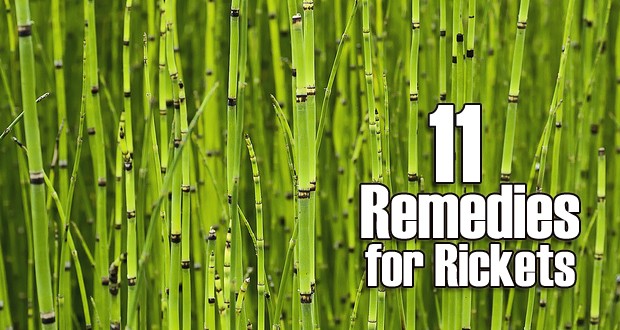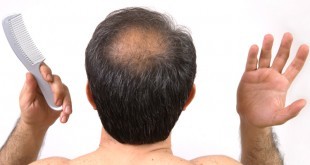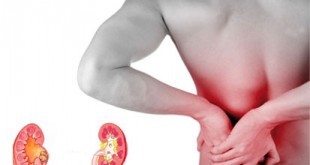
Rickets is a disease caused by lack of vitamin D in children. Lack of vitamin D makes it impossible for a child’s body to absorb calcium and phosphorus leading to weak bones. In adults, this disease is called osteomalacia. The origin of the term Ricket can be traced back to the Anglo-Saxon word ‘wrikken’ which means “to twist”. As the bones get softened and deformed which results into twisting or bending of the child’s body, this deficiency disease got the name ‘Rickets.’ It is most likely to notice the first symptoms of rickets when a child is teething. The child becomes restless and pale and his muscles look flabby and toneless. Child’s limbs take unnatural postures. His head sweats a lot and abdomen seems to protrude. The child may often suffer from diarrheaand even anemia. Weak bones and joints bend and cause such deformities as bow legs, knock knees and pigeon breast. If detected earlier, it is possible to treat rickets. Home remedies for rickets mostly include diet rich in calcium, phosphorus and vitamin D including such measures that will replenish the vital minerals and vitamins in child’s body.
1. Get Enough Sunrays for Vitamin D as Rickets Remedy
Human skin contains provitamin which is activated when in sunlight. Vitamin D is thus synthesized in the skin by sun. If a child is exposed to sunrays, the deficiency of vitamin D may be countered. This vitamin, however, doesn’t cures rickets by itself. It promotes the absorption of calcium and phosphorus by the body so that the bones may get stronger.
Do this:
- Expose the child to the mild sunrays in morning hours, not more than 15-20 minutes.
- If skin is darker, you need to expose the child to sunrays for longer than normal.
- Do not tightly cover the child with clothes. Use loose clothings or expose the skin directly to sunshine though not for very long and only in the morning hours.
- Be more careful with infants, toddlers and small babies. Their sensitive skin may burn so cover them with light clothes when exposing them to sunlight.
Just remember, do not cover your children with unnecessary clothing when he or she goes out in sun,
plays or just enjoys fresh air! However, if going out in the noon or when sunrays are very strong, use sunscreen because these may damage skin and even cause skin cancer.
2. Cod Liver Oil Remedy for Rickets
Cod liver oil has been the favorite remedy of yesteryears’ mothers. And why not! In the beginning of twentieth century, poor children were the easy victims of rickets. The discovery of vitamin D and the anti-rachitic properties of cod-liver oil by 1930s were the major benchmarks that got the United States get rid of rickets. Even before this discovery, northern Europeans used cod liver oil to get relief from rheumatism, aching joints, and stiff muscles, way back since 17th century! Cod liver oil has large quantities of vitamins A, D, and omega-3 fatty acids. While vitamin A, among other health benefits, is essential for immune system and growth of bone, Vitamin D is the major compound that prevents and treats rickets along with improving muscle function. It also prevents type 1 diabetes, hypertension, and some common cancers. It, thus, seems wise to have cod liver oil for rickets even if it tastes bad.
Do this:
- Take 1 tsp of cod liver oil daily. Liquid cod liver oil smells but you can find flavored versions too. However, too much usage of scents and flavors may leave oil rancid. Thus go for mild flavors or the plain cod liver oil.
3. Oily Fish as Remedy for Rickets
There are very few foods that have natural vitamin D in them. Oily fish are one of them. It is more important to eat fish during winter months when daylight reduces to a considerable level. It is no less important in the summer months too when children remain inside and keep themselves busy with indoor games only. So, make tuna sandwiches, mackerel dip or add salmon to your fish pie but include fish in your diet to get more of vitamin D.
What oily fish are good sources of vitamin D?
- Sardines
- Mackerel
- Pilchards
- Fresh tuna
- Salmon
- Catfish
4. Calcium Rich Diet for Rickets
While lack of vitamin D leads to non-absorption of calcium by the body, there is yet another consequence of not having dietary calcium. When the minerals, calcium and phosphates, lower in the blood, the body starts producing hormones which cause calcium and phosphate to be released from the bones. This results in weak and soft bones. Therefore, along with vitamin D, calcium rich diet is also essential to prevent and cure rickets.
What are good sources of calcium?
- Dairy products like milk, yogurt and cheese
- Soya beans and tofu
- Leafy green vegetables like broccoli and cabbage
- Nuts
- Fish whose bones are also eaten like sardines and pilchards.
5. Moti Bhasma- Pearl Ash Ayurvedic Remedy for Rickets
Here’s a unique treatment for rickets. In fact, it is an ancient Ayurvedic remedy where ‘Moti Bhasma’ or pearl ash is given to treat rickets. Pearl is rich in natural calcium and thus very beneficial for those who lack in this mineral. Pearl (Mytilus Margaritiferus) is composed of calcium, traces of magnesium, zinc, strontium, selenium and a variety of amino acids. Moti bhasma is readily available in powder form in any health store that sells Ayurvedic products. The Ayurvedic preparation, ‘Moti Bhasma’ is made with special efforts where pearl’s natural components are reduced to their oxide or sulphide form. Pearls are purified and then reduced to oxide through calcination.
Get this:
- Moti bhasma- 60-125 mg
- Honey- 1-2 tsp
Do this:
- Mix moti bhasma with honey
- Have this twice a day.
It is recommended that you take moti bhasma under the expert guidance of an Ayurvedic practitioner.
6. Dandelion Herbal remedy for Rickets
Dandelion herb is very rich in nutrients. Dandelion root and leaves are a good source of vitamins like vitamin A, C, D, and B-complex. They are also high in minerals iron, magnesium, zinc potassium, manganese, copper, choline, calcium, boron, and silicon. This is one of the herbs that nutritionists recommend for rickets too.
Ways to use dandelion herb for rickets
- Make soup of dandelion leaves.
- Make tea of dandelion herb.
How to make Dandelion Tea?
Get this:
- Dried dandelion leaves- 1 tsp
- Boiling water- 1 cup
Do this:
- Put dandelion leaves in a pot
- Pour hot water over it.
- Steep for 3 minutes
- Stir and let it steep for another 1 minute.
- Strain and have the tea.
7. Oatstraw Infusion for Rickets
Oatstraw is a very nutritional herb. Oat straw is derived from the oat plant which is left after harvesting the grain. It is basically the dried stems and leaves of oat plant that can be found in any herbal store. Oatstraw is a very rich source of calcium, Vitamin A, magnesium and Niacin (B3). Oatstraw can be used not only to treat rickets but also osteoporosis, bone cancer, and broken bones. Give a daily supplement of calcium to your child or have it yourself for strong bones by having a cup of oatstraw infusion (and not tea). You may like to brew it with a pinch of horse tail herb for better results.
How to make oatstraw infusion for rickets?
Get this:
- Oatstraw dried herb- 1 ounce (about 1 cup)
- Jar with lid- A quart jar (about 1 liter in volume)
- Boiling water- enough to fill the jar
- Horsetail herb- 1 tablespoon
Do this:
- Place the oatstraw in the jar.
- Add a pinch of horsetail herb (if not there, don’t worry, make it without horsetail herb. Get it for the next time)
- Fill the jar with boiling water.
- Cover the jar with its lid.
- Leave the oatstraw to steep for 5-10 hours. The longer you leave it to infuse, the better it is. You may also like to do it overnight.
- After about 5-10 hours, strain the thing.
- Drink 1 cup of this oatstraw infusion. You may even have more of it but have at least 1 cup daily.
- Store the remaining infusion in refrigerator. Use the liquid within 36 hours. If you can’t use it within this time, do not take the left over infusion. You may use it to have oatstraw bath.
8. Give Oatstraw Bath For Rickets
As oat straw or Avena sativa nourishes and protects the nervous system along with providing B vitamins, magnesium, calcium and antioxidants, it is also good to have oatstraw bath twice a week for those having rickets or those deficient in calcium and vital minerals.
How to take oatstraw bath for rickets?
1st way of taking oatstraw bath
- Get two liters oatstraw infusion (make this infusion as suggested in the remedy with oatstraw infusion).
- Reheat and strain the oatstraw infusion.
- Mix this oatstraw infusion to a tub of hot water. Let it cool down till you can tolerate.
- Immerse your body in this water and relax.
2nd way of taking oatstraw bath
- Get 1 kg oatstraw.
- Place this oatstraw in a 4 liters large water tub.
- Boil water and pour over the dried oatstraw herb.
- Let it cool down a little.
- Bathe with this water.
- Do not remove the straws while bathing.
Take oatstraw hot baths at least once or twice a week.
9. Nettle Herbal Infusion for Rickets
Nettle is one of the most nutrient-rich herbs having a variety of vitamins and minerals in it. Many nutritionists recommend nettle herb for its calcium and magnesium reserves. It also has potassium, iron, chromium, selenium, trace minerals, Chlorophyll, manganese, silica, iodine and sodium other than vitamins A, C and E, B vitamins and beta-carotene. Nettle has been widely identified as one of the natural remedies for rickets when taken as infusion. You can alternate between oatstraw and nettles herbal infusion to get benefits from both the herbs.
How to make nettle herb infusion?
Get this:
- Nettle dried herb- 1 ounce (about 1 cup)
- Jar with lid- 1 quart/liter jar
- Hot water (not boiling)- about 1 liter, enough to fill the jar
Do this:
- Put the nettle herb into the jar.
- Pour hot water over the herb and fill the jar to the top.
- Cover it tightly with the lid.
- Let it steep for about 4-8 hours.
- After about 4-8 hours, strain and drink the nettle infusion.
If you take two cups of nettle infusion daily, you can meet all your vitamins and minerals requirement for the day.
10. Horsetail Tea Remedy for Rickets
Horsetail herb has many mineral salts, most importantly silica along with potassium, manganese, magnesium, and many trace minerals. Why is this herb one of the remedies for rickets is because horsetail’s silica or silicone content is converted into natural calcium by the body when the herb is taken internally. Horsetail is traditionally administered to people suffering from anemia or general debility as well as to cleanse and heal wounds. Some modern studies have also found that fractured bones can be healed quickly when horsetail is used by the patient. The silicon trace element of horsetail helps find protein molecules together in the blood vessels and connective tissues. Silicon not only promotes growth and stability of skeletal structure but also makes collagen which holds our skin and muscle tissues together. Horsetail can thus be used as a remedy for rickets, osteomalacia, osteoporosis, sprains, dislocated joints, pulled hamstrings and torn ligaments.
Make Horsetail tea for rickets
Get this:
- Fresh or dried horsetail herb- 1 tsp
- Boiling water- 2 cups
Do this:
- Put the horsetail herb in a vessel.
- Pour boiling water over it.
- Cover and steep for 3-5 minutes.
- Strain.
- Have this tea after meals.
- Have one and half cup of this horsetail tea in a day, after meals. Divide the tea to have after two or three meals but don’t have more than 1 – ½ cups a day.
11. Diet Remedies for Rickets
As rickets is a deficiency disease, the best remedy for it is to have nutrient-rich meals that are full of vitamin D, calcium and phosphorous along with other minerals. Here is an ideal diet plan for rickets.
Diet Plan for Rickets
- Eat vitamin D rich foods– cod liver oil; fish including salmon, mackerel, tuna; whole eggs (egg yolk has vitamin D in it); and yogurt. You may also have foods fortified with vitamin D like orange juice, milk, margarine and breakfast cereals.
- Have calcium rich foods– dairy products like milk, yogurt and cheese; leafy green vegetables such as kale and spinach.
- Have phosphorous rich diet– whole-wheat; halibut, beef, chicken and turkey; dairy products like milk, cheese and yogurt; eggs; and salmon fish.
Vegetarian Diet Plan for Rickets
Children who only eat vegetarian foods are included in the risk group for developing rickets because their vegan diet might lack calcium or vitamin. Here is a vegetarian diet plan for such children.
- Whole grains and beans– rice, oats, quinoa, barley, lentils, black beans, etc.
- Leafy green vegetables– kale, collards, etc.
- Yellow-orange vegetables- carrots, turnip, squash etc.
- Cruciferous vegetables– cabbage, broccoli, etc.
- Seaweeds– kelp, dulse, hijiki, etc.
- Nuts– walnuts and almonds
- Fresh fruits and dry fruits– banana, oranges, raisins, figs
- vegetables like onions and garlic
- Sweets made with honey and maple syrup
The key to fight off rickets, thus, is to have required amounts of vitamin D, calcium and phosphorous. The best remedies for rickets are to include foods rich in these nutrients in our diet and expose ourselves to sunrays for some portion of our day. The further you stay from the equator, the longer you require to be exposed to the sun so that your body can produce vitamin D. Various herbal and home remedies for rickets too do the same, give you vitamins and calcium or minerals and help you synthesize these nutrients in your body.
Source: RapidHomeRemedies
 We are sharing information for knowledge. Presented by. SocialDiary.Net
We are sharing information for knowledge. Presented by. SocialDiary.Net



